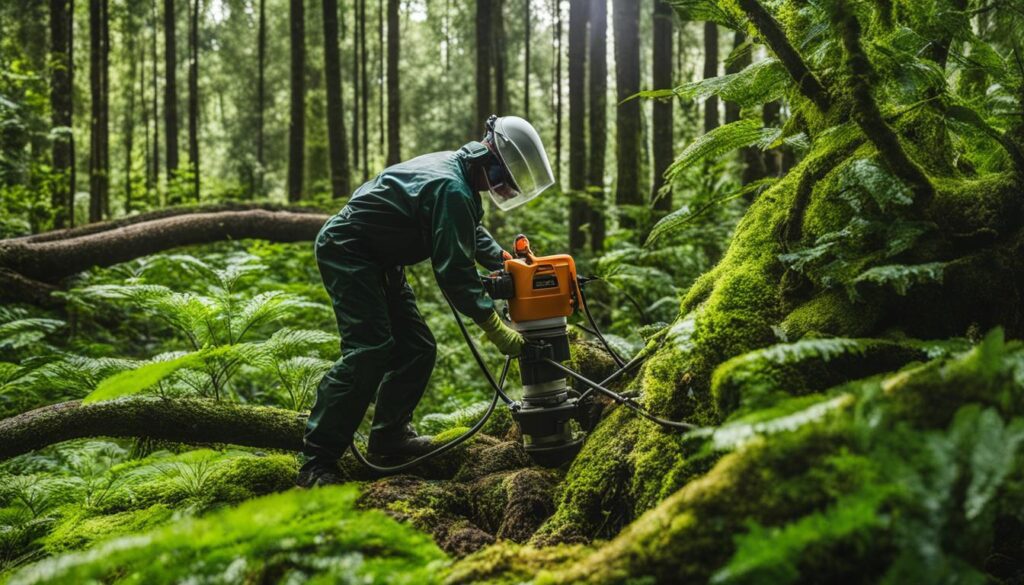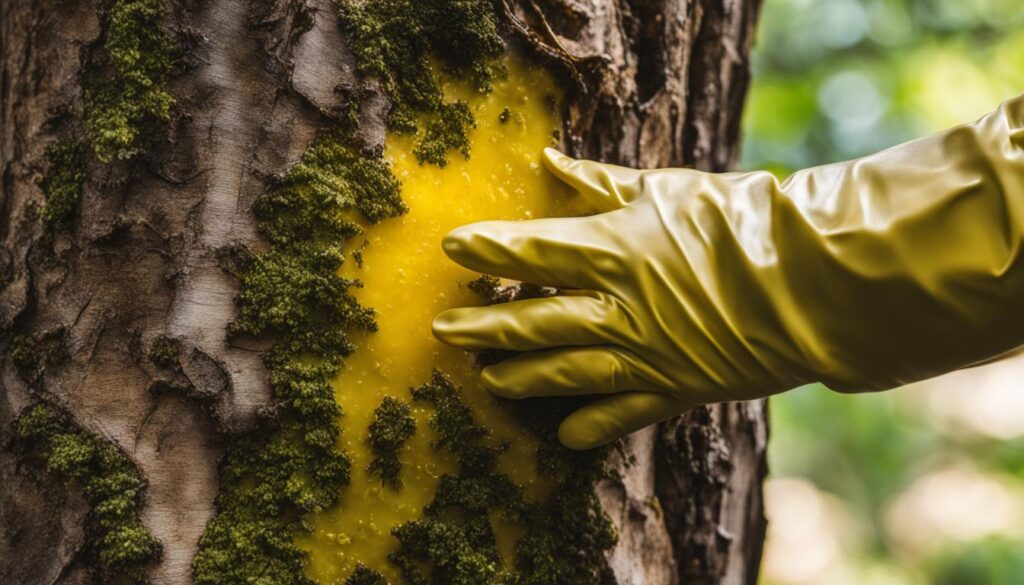Bacterial slime flux, also known as bacterial wetwood, is a common tree disease that affects various species such as elm, ash, maple, and oak. Slime flux is caused by a bacterial infection in the inner sapwood and outer heartwood of the tree, usually associated with wounds or environmental stress. In order to effectively treat and manage slime flux, it is important to follow proper treatment methods that promote the overall health and resilience of the tree. There are various options available for bacterial slime flux treatment, and implementing these tips can help control and prevent the spread of this tree ailment.
Key Takeaways:
- Proper treatment methods promote tree health and resilience in bacterial slime flux control.
- Effective bacterial slime flux treatment options are available for managing this tree disease.
- Treating slime flux in trees involves addressing the bacterial infection and preventing its spread.
- Bacterial slime flux prevention can be achieved through proactive measures to maintain tree health.
- Implementing these tips can help control and prevent the spread of bacterial slime flux.
Understanding Bacterial Slime Flux Disease
Bacterial slime flux disease is a prevalent tree ailment characterized by oozing, weeping spots on the bark of affected trees, commonly found near wounds or pruning scars. This disease is caused by bacterial infection, primarily by species such as Enterobacter cloacae. It can impact various tree species, including elm, willow, ash, maple, birch, hickory, beech, oak, sycamore, cherry, and yellow-poplar.
The bacteria responsible for slime flux disease feed and grow within the tree’s wounds, deriving nutrients from the sap. As a result, the disease alters the wood cell walls and increases moisture content, leading to the weeping of dark liquid streaks and emitting a foul odor on the bark. Although there is no active treatment for slime flux rot, prioritizing the overall health of the affected tree can aid in overcoming the infection and sealing off the damaged area.
It is crucial to understand the symptoms, causes, and effects of bacterial slime flux disease to effectively manage and prevent its spread. The next section will discuss the various symptoms exhibited by infected trees and the possible causes behind the onset of this bacterial infection.
Identifying Symptoms of Bacterial Slime Flux
When it comes to bacterial slime flux, recognizing the symptoms is crucial for prompt treatment and management. The most evident sign of this tree disease is the presence of oozing, weeping spots on the bark. These spots can be quite noticeable and are often accompanied by a foul odor. The slime itself may appear white, slimy, and frothy, creating a distinct visual disturbance.
In some cases, the slime may dry and form a whitish or pale gray crust on the bark. Additionally, dark brown or black streaks can be observed on the trunk or branches, indicating the presence of bacterial slime flux. These streaks are caused by the dark liquid seepage within the tree.
Another important indicator of this disease is tree stress. Bacterial slime flux can lead to various signs of stress, such as wilting, leaf scorch, premature leaf drop, and even branch dieback. These symptoms are reflective of the detrimental effects of the bacterial infection on the tree’s overall health and vitality.
To ensure effective treatment and management of bacterial slime flux, it is important to properly identify these symptoms. Promptly addressing the presence of oozing spots, weeping bark, dark liquid streaks, foul odors, and signs of tree stress can help mitigate the damage caused by this disease. Early intervention is key to preserving the health and longevity of the affected trees.
Note: The image above illustrates the symptoms of bacterial slime flux.
Treating Bacterial Slime Flux Disease
Treating bacterial slime flux disease involves prioritizing the overall health of the tree. While there are no active measures to treat the bole rot caused by slime flux, focusing on tree health allows the tree to isolate the infected areas and foster the growth of healthy wood around the diseased portion. It is important to note that using insecticides to prevent the spread of slime flux is ineffective, as insects are neither the cause nor the carriers of the disease. In fact, removing decaying wood can benefit the tree since insects feeding on the rot do not contribute to the occurrence or perpetuation of slime flux. Therefore, the key to effectively treating bacterial slime flux lies in promoting tree health and minimizing further injury or stress to the tree.
By implementing measures to enhance tree health, such as proper watering, fertilization, and mulching, we can support the tree’s natural defense mechanisms. Additionally, isolating infected areas by pruning and removing diseased branches is essential to contain the spread of slime flux. Regular inspections by a certified arborist can help identify infected areas and provide guidance on appropriate pruning techniques.
It is crucial to remember that prevention is better than cure when it comes to slime flux. Ensuring the tree’s long-term health and vitality through regular maintenance and soil care can significantly reduce the risk of infection. Proper pruning practices, including removing dead or dying branches promptly, discourage bacterial entry points and contribute to the overall health of the tree.
Ultimately, treating bacterial slime flux is a proactive process that centers around tree health management. By implementing sound practices and seeking professional guidance when necessary, we can effectively minimize the impact of slime flux and protect the long-term wellness of our trees.
Preventing Bacterial Slime Flux Disease
The best way to control bacterial slime flux is through prevention. By taking specific measures, you can reduce the risk of tree wounds and environmental stress, both of which are commonly associated with slime flux. When planting trees, select locations that have minimal soil compaction from pedestrian and vehicle traffic. This will help prevent damage to the trees’ root systems and minimize the risk of infection.
Another important preventive measure is to promptly trim and remove any broken or torn branches. These damaged areas can serve as entry points for bacteria, making the tree more susceptible to slime flux. By eliminating these potential entry points, you can reduce the risk of infection.
Ensuring that trees are not subjected to unnecessary environmental stresses can also help prevent bacterial slime flux. Extreme temperatures and drought can weaken trees, making them more susceptible to infections. Taking steps to mitigate these stresses, such as providing adequate irrigation during dry periods and avoiding excessive pruning during extreme weather conditions, can help maintain tree health and reduce the likelihood of slime flux disease.
Additionally, following proper pruning practices is crucial in preventing bacterial slime flux. Improper pruning techniques can create wounds on the tree’s bark, providing an opportunity for bacteria to enter and cause infection. Hiring certified arborists who are trained in proper tree maintenance can ensure that pruning is done correctly, minimizing the risk of slime flux.


Remember, prevention is key when it comes to bacterial slime flux. By implementing these preventive measures, you can significantly reduce the incidence of slime flux in your trees and promote their overall health and longevity.
Managing Slime Flux Disease
When it comes to managing slime flux disease, the approach may vary depending on the extent of the infection. If the disease is localized in the lateral branches, it can be helpful to remove the affected limbs using proper pruning techniques. This can help contain the infection and prevent further spread.
However, if the infection has reached the trunk of the tree, there is limited assistance that can be provided. In such cases, it is crucial to focus on providing the tree with adequate water and nutrient supply to support its overall health and resilience. Well-managed trees are more likely to produce less slime and are better equipped to withstand the effects of slime flux.
Additionally, washing off the slime from the tree with a hard spray of water can help reduce its toxic effects. However, caution must be exercised to avoid washing the slime onto other plants, as it can potentially harm them.
Proper care, including appropriate water and fertilizer supply, plays a significant role in managing slime flux and prolonging the life of infected trees. By ensuring that the tree receives the essential resources it needs, you can help it fight against the disease and maintain its overall health.
Professional Bacterial Slime Flux Treatment Services
In cases where bacterial slime flux is a persistent issue or when professional expertise is required, it is recommended to seek the services of a certified arborist or tree disease control service. These professionals have the knowledge and skills to identify, manage, and prevent slime flux in trees. With their expertise, they can provide effective strategies for treating wetwood and other tree diseases. By entrusting the treatment to professionals, you can ensure that the proper techniques and methods are employed to control and manage bacterial slime flux.
If you’re dealing with stubborn slime flux or need assistance with wetwood treatment and bacterial infection management, certified arborists are the go-to experts. They possess specialized training and experience in professional tree disease control. By hiring certified arborists, you can rest assured knowing that your trees are in the hands of knowledgeable professionals who prioritize tree health and have access to the latest treatments and techniques.
Professional slime flux treatment services offer a comprehensive approach, starting with a thorough assessment of the infected trees. Certified arborists will carefully examine the symptoms, identify the exact cause of the bacterial infection, and develop a tailored treatment plan to mitigate and control the slime flux. This may involve targeted pruning, removing the infected wood, and implementing preventive measures to minimize future risks.
When it comes to wetwood treatment and bacterial infection management, time is of the essence. Hiring professional services ensures timely intervention and appropriate treatment to address the issue effectively. They have access to specialized equipment and tools necessary for treating bacterial slime flux, and their expertise enables them to make accurate decisions throughout the treatment process. Additionally, they stay updated with the latest advancements in tree disease control, allowing them to deliver the most effective and efficient solutions.
By opting for professional bacterial slime flux treatment, you not only protect your trees but also safeguard other vegetation in your surroundings. The controlled management of bacterial slime flux prevents the spread of harmful bacteria, contributing to the overall health and well-being of your landscape.
Image:


Tips for Preventing Bacterial Slime Flux in Trees
Along with professional tree disease control, implementing preventive measures can significantly reduce the risk of bacterial slime flux in trees. To protect your trees from this common ailment, it is essential to prioritize tree maintenance and follow proper care techniques.
Avoid Tree Injuries
Prevent the entry of bacteria into your trees by keeping lawn care and construction equipment at a safe distance. Accidental wounds on tree bark can create an entry point for bacterial slime flux. Ensuring that proper pruning techniques are used can also help minimize the risk of tree injuries.
Plant in Low Soil Compaction Areas
When planting new trees, choose areas with minimal soil compaction. Soil compaction can limit the root development and nutrient absorption of trees, making them more susceptible to bacterial slime flux. Prioritizing healthy soil conditions will contribute to the overall success and longevity of your trees.
Mitigate Environmental Stressors
Take steps to mitigate environmental stressors that can weaken your trees and make them more vulnerable to disease. This includes practices like watering trees during drought conditions and providing proper insulation during extreme temperatures. By reducing environmental stress, you can enhance the tree’s natural defenses against slime flux.
Incorporating these preventive measures into your tree care routine and prioritizing tree maintenance will help you effectively reduce the incidence of bacterial slime flux. Remember, a healthy and resilient tree is better equipped to resist infections and thrive in its environment.
Conclusion
Bacterial slime flux is a common tree disease that can cause rot and decay in various tree species. While there is no active treatment for this condition, focusing on maintaining tree health and preventing further injury can help trees overcome slime flux and seal off the affected areas.
By following proper pruning practices and avoiding tree stress, you can minimize the risk of bacterial slime flux. The expertise of certified arborists can also be invaluable in managing and preventing tree infections. These professionals have the knowledge and skills to effectively control slime flux and provide guidance on tree disease management.
Remember, a healthy and resilient tree is better equipped to resist infections. By prioritizing tree maintenance and seeking assistance from certified arborists when needed, you can ensure the long-term health and vitality of your trees.
FAQ
What is bacterial slime flux treatment?
Bacterial slime flux treatment refers to the methods and strategies used to control and manage slime flux disease in trees caused by bacterial infections. Treating slime flux involves promoting tree health and preventing further injury or stress to the tree.
How can I identify bacterial slime flux disease?
Bacterial slime flux disease is characterized by oozing spots or weeping bark on the tree, often near wounds or pruning scars. Other symptoms include dark liquid streaks, foul odor, and signs of tree stress such as wilting, leaf scorch, premature leaf drop, and branch dieback.
What is the best way to treat bacterial slime flux?
The best way to treat bacterial slime flux is to focus on maintaining tree health. There are no active treatments for the disease, but by promoting tree health, the tree can isolate the infected areas and grow healthy wood around the diseased portion.
How can I prevent bacterial slime flux in trees?
Preventing bacterial slime flux involves taking measures to reduce the risk of tree wounds and environmental stress. This includes choosing suitable locations for tree planting, promptly removing broken branches, and mitigating environmental stressors such as drought and extreme temperatures.
Is there professional treatment available for bacterial slime flux?
Yes, professional tree disease control services, such as those provided by certified arborists, can offer expertise in identifying, managing, and preventing bacterial slime flux in trees. These professionals can provide effective strategies for treating slime flux and other tree diseases.
How can I manage slime flux disease in trees?
Managing slime flux disease involves proper tree maintenance, including pruning techniques and ensuring adequate water and nutrient supply. Well-managed trees are more likely to produce less slime and are better equipped to withstand the effects of slime flux.
What should I do to prevent bacterial slime flux in trees?
To prevent bacterial slime flux, it is important to maintain tree health and avoid injuries. This includes practicing proper pruning techniques, avoiding soil compaction, and taking steps to mitigate environmental stressors like drought and extreme temperatures.
Should I seek professional help for bacterial slime flux treatment?
In cases where bacterial slime flux is persistent or professional expertise is required, it is recommended to seek the services of a certified arborist or tree disease control service. These professionals have the knowledge and skills to effectively manage and prevent slime flux in trees.
Are there any additional tips for preventing bacterial slime flux in trees?
Along with proper tree maintenance, it is important to avoid tree injuries by keeping lawn care and construction equipment at a safe distance. Additionally, hiring certified arborists for tree maintenance and following their recommendations can help prevent bacterial slime flux in trees.



